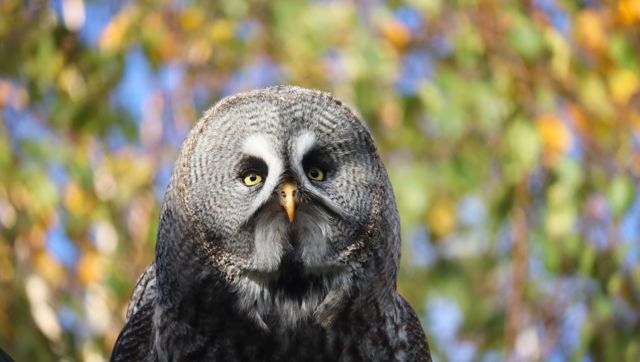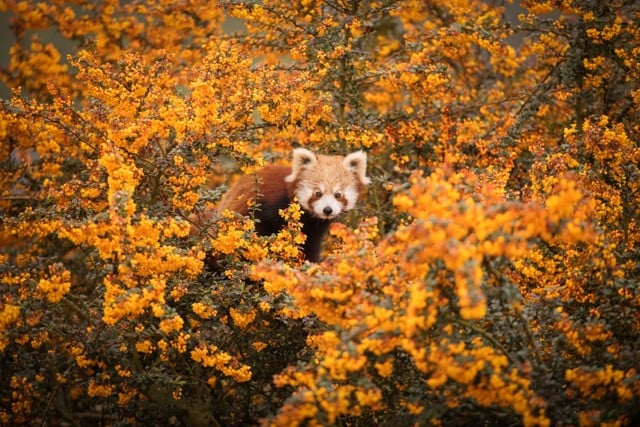Overview
The great grey owl is one of the largest owls in the world, and the largest to live in the northern hemisphere. The most obvious feature of a great grey owl is its large facial disk, a satellite dish of feathers which directs all sounds towards their ears. In the great grey owl it is nearly perfectly circular, giving a very striking look to this species.

All about us
| Distribution: | Scandinavia, northern North America, and northern Asia |
|---|---|
| Habitat: | Dense boreal and coniferous forest |
| Height: | 61cm to 84cm in length |
| Weight: | 800g to 1,500g |
| Lifespan: | Wild 12 years, in captivity 30 to 40 years |
| Threats: | Timber harvesting causes a lack of suitable nest sites |
About us
Scientific name: Strix nebulosa
Their scientific name comes from the Greek ‘strizo’, meaning to screech, and the Latin ‘nebulosa’, meaning dark or clouded, referring to their grey colouration.
The great grey owl communicates with a number of vocalisations. Its primary call is a very soft, low-pitched hoot "whooo-ooo-ooo-ooo", which can be heard over half a mile away in the right conditions. There are a number of territorial calls, and when excited they can growl, shriek, hoot, wail, and snap their bills. The young owlets will make a series of calls in the nest, including calls to get attention and when squabbling with nest mates.
When threatened or acting aggressively they will make a loud clicking noise with their beak, and will often growl at predators, with wings spread.

Great grey owl facts
The great grey owl is one of the tallest species of owl in the world, and the largest owl species living in the northern hemisphere. Their name is derived from the mottled grey colouration of the body. There is a large facial disk, a disk of feathers used to direct sound into the ears. The facial disk is circular, and grey in colour, with a white moustache shaped chin strap, and white patches near the eyes. The legs and feet are feathered, with long sharp talons on each toe. The great grey owl is a large owl, however only weighs a small amount. Most of its body has a thick layer of feathers coating it, to insulate from the harsh conditions of its habitat.
The wings of an owl are finely serrated so that they can fly silently. This is to allow the owl to approach its prey silently without it hearing it first, and so that they owl itself can hear its prey over its own sounds.
The eyes of owls are adapted to be like a pair of binoculars. They are fixed in place, allowing for detailed long distance vision for hunting, but this does mean their close range vision is very poor. The eyes of a great grey are small to minimise heat loss, and bright yellow in colour. To look around the owl has to move its entire head, it is a common myth that they can turn their head all the way around, it actually only rotates around 270 degrees horizontally, and around 90 degrees vertically. To be able to do this the owl has extra bones in their neck. Most vertebrates, including us, only have 7 vertebrae in their neck, whereas an owl has 14.
To cope with the lack of short range vision they have a group of sensitive feathers, called crines, around their beak. These sensitive feathers are used to locate dead prey.
Owls have very sensitive hearing, used to locate prey either hidden under snow or other coverings, or to hunt in the dark. Owl’s ears are holes hidden beneath the feathers, one further up than the other, allowing the owl to pinpoint the location of a sound. This ability lets them build a sort of sound map and locate prey, often in complete darkness, by sound alone. The great grey owl has very sensitive hearing, and is capable of hearing a small rodent’s heartbeat several feet under the snow. The feathers of an owl’s face help with this hearing, by forming a facial disk, a disk of feathers used like a satellite dish to help point any sound towards these ears. In the great grey owl this facial disk is more prominent than some other species, due to it relying on its hearing so heavily to locate prey.
The great grey owl's diet is made up of around 80-90% small rodents. They mostly hunt voles, but will also eat gophers, weasels, squirrels, rabbits, rats and mice. They will also take some birds, including thrushes, grouse, and ducks.
The great grey owl will hunt mainly during early morning and late afternoon, but will also hunt during other daylight hours, and may even hunt at night, depending on changeable light and weather conditions, and prey availability. They will sit on perches and wait to hunt, or may fly through the forest around a metre above the ground hunting. When the ground is snow covered the great grey owl will hunt using its hearing alone, to locate prey, and dive into the snow, feet first, using its wings to bounce back out again. They will dive into snow as deep as their body size doing this. This is known as ‘snow plunging’, and is only done by a few owl species, who are capable of it due to their superior hearing. Often the imprints left in the snow from the owls wings are the only indication of the presence of the species in an area.
The strong feet and talons are used to catch the prey, which is then dispatched with a nip through the back of the skull with its beak. Depending on the size of the prey item they will swallow it whole, or if larger tear it apart with the beak. Owls produce a pellet, a small package of all the parts of their food they cannot digest, such as the bones and fur or feathers.
Due to the changeable conditions of their habitat the great grey owls nest site choice, and mate choice will depend on food abundance. If an area have a stable prey population they may stay with the same mate, or nest site for several years, however they will move on to new areas as soon as food levels drop.
Breeding usually starts in late winter, when the male will find a nest site and then call to a female to attract her. The courtship will involve the male feeding the female and mutual preening. Great grey owls will not build new nests, but instead prefer to use other birds old nests, such as ravens, goshawks, and other raptors, and will often nest in broken tree stumps, on manmade platforms, and occasionally on the ground.
Living in harsh conditions, abundance of food will predict whether a great grey owl will breed or not, some years they will not, and when they do the number of eggs laid is usually in relation to how much food is available. The eggs will be incubated for around 28 days, starting after the last egg is laid. The male will bring her food to the nest during this time. Female owls are generally a third larger than the male, so that they have the extra energy to incubate the eggs and can survive this period.
Chicks will leave the nest and climb around well at the age of around 3 to 4 weeks. They will fledge at around 8 weeks, but will stay near the nest, with the female caring for them, for several months after before becoming independent.
The great grey owl reaches sexual maturity at around three years, and can live up to 12 years in the wild or up to 30 or even 40 years in captivity.
All of our birds of prey are flown daily. This has many benefits to the animal. Firstly it allows the animal to exercise, keeping them fit, and developing flying muscles. It also allows them to perform their natural behaviours, for some of our birds of prey this may include various hunting techniques such as catching prey mid-flight, and chasing down ground prey, or killing a (rubber) snake.
Each bird has a varied diet, just as it would in the wild, mimicking the varying nutritional properties of each food type and the quantities.
Young great grey owls can be preyed upon by great horned owls, marten, and wolverines. Adults are rarely preyed upon.
Most deaths are caused by starvation, with a lack of prey items during harsher periods of the year. Electrocution, traffic accidents, and shootings can occasionally occur.
Deforestation and human disturbance have a detrimental effect on the great grey owl. A lack of nest sites, and a lack of prey items, will also cause a local population to decline. Chemicals used to minimise rodent numbers can cause poisoning throughout the food chain.
In the USA they are seen as a threatened species, and are protected. There are laws in place governing logging in great grey owl habitats to minimise loss of nest sites.
Wildfires can often benefit great grey owls, creating tree stumps suitable for nest sites, and causing an increase in the rodent population.
They are listed as appendix III of CITES, which means the trade and export of this species is allowed, but follows strict procedures and paperwork to allow safe and legal export of the species.

